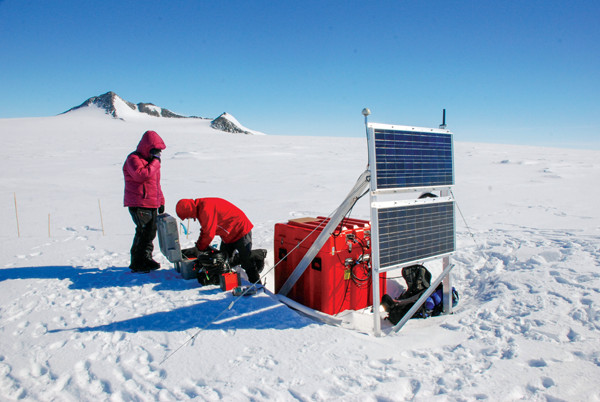
by Mary Caperton Morton Thursday, October 2, 2014

The HOWD seismic station in Antarctica where ice quakes were measured following the Maule earthquake in Chile. Credit: Erik Kendrick, Ohio State University.
On Feb. 27, 2010, a magnitude-8.8 earthquake struck the subduction zone off the coast of Chile. The resulting Rayleigh surface waves rippled around the world, triggering small earthquakes in many different tectonic settings, including Antarctica. As the surface waves moved across the white continent, a third of Antarctic seismic stations reported shaking coming from so-called “ice quakes.”
Most of the small ice quakes “were triggered during or immediately after the passing of long-period Rayleigh waves generated from the Chilean mainshock,” says Zhigang Peng, a geophysicist at Georgia Tech in Atlanta who co-authored a study on the ice quakes in Nature Geoscience in August 2014. Some were quick bursts, ending in less than a second, whereas others resembled tremor-like signals up to 10 seconds long.
Ice quakes differ, however, from the conventional microquakes and tremors triggered by both Love and Rayleigh surface waves because although microquakes can be triggered by both shearing and volumetric deformation from distant events, ice quakes only occur in response to volumetric deformation.“Such differences may be subtle, but they tell us that the mechanisms of these triggered ice quakes and small earthquakes are different,” Peng says.
“We suspect they simply reflect fracturing of ice in the near surface due to alternating volumetric compressions and expansions as the Rayleigh waves passed through Antarctica’s ice,” Peng says. Such ice quakes are unlikely to present a significant hazard, Peng says, but the new finding “adds another type of seismic phenomenon to the literature that can be triggered by large distant events.”
© 2008-2021. All rights reserved. Any copying, redistribution or retransmission of any of the contents of this service without the expressed written permission of the American Geosciences Institute is expressly prohibited. Click here for all copyright requests.